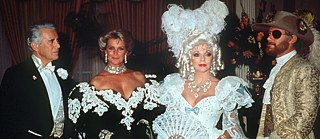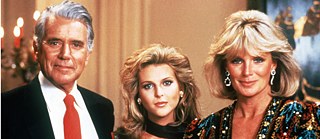Queer writing as an art form
Some Notes on My Gay Feelings

By William Johnson
My aesthetics were gay first.
When I was ten years old I was obsessed with American soap operas. I had no interest in juvenile programming, instead I was enraptured by the small town stunts and theatrics of General Hospital and the class obsessed Dynasty. When the “queen of all she surveys” Alexis Carrington Colby accidently drove off a bridge in a fit of love-starved mania, I felt her pain. When the archetypal lovers on the run Luke Spencer and Laura Webber shared an after-hours romantic date in a mall, I swooned in romantic bliss. When Steven Carrington assembled his family to histrionically discuss his sexuality, I found an over-the top brother in arms. Melodrama, overstated feelings, the obscene, extreme sincerity bordering on lunacy are all signposts of the stereotypical male homosexual condition and the defining attributes of my burgeoning ten year old sensibility. My taste in art was faggy before I could be.
Why do these signpost exist? Why do some gay people covet and create these uncanny artifacts? I think it all stems from longing. Desire shapes our worldview. Even at a young age, my yearnings had a singular, highly charged sissified emotional focus. I wanted to be loved! I wanted to be understood! I wanted make a grand entrance! I wanted to sit in my room and brood! I was always looking for cues in pop culture to make sense of it. Like Alexis, like Steven, like Luke and Laura, my sad/happy feelings and my off-center passions were dizzying.
That distinctively gay way of being, moreover, appears to be rooted in a particular queer way of feeling. And that queer way of feeling—that queer subjectivity—expresses itself through a peculiar, dissident way of relating to cultural objects (movies, songs, clothes, books, works of art) and cultural forms in general (art and architecture, opera and musical theater, pop and disco, style and fashion, emotion and language). As a cultural practice, male homosexuality involves a characteristic way of receiving, reinterpreting, and reusing mainstream culture.
From “How To Be Gay” by David Halperin
In his book How to Be Gay scholar and writer David Halperin offers a wide ranging analysis of this particular gay sensibility: the ways in which queer culture takes heteronormative culture and turns it inside out, how camp “works to drain the sufferings of the pain that it also does not deny.” My one point of contention with Halperin is that he argues these modes of appreciation are passed down, learned from one gay man to another. No one taught to me to love Dynasty, Diana Ross or Lil Kim for that matter, I just did. My desire sought out these narratives. I was shockingly enough really “Born this Way.”
As I grew slightly older, I discovered that these aesthetical cues were potent. If centered correctly, these wayward collection of tastes could produce powerful totems: gay art that spoke in an explicitly gay voice. Manuel Puig, Edmund White, Essex Hemphill, Marlon Riggs, Reinaldo Arenas, Andy Warhol, and John Waters showed me the way. Gay aesthetics often lead to inspired, deranged, and magnificent art.
In my senior year of high school, I was assigned a creative class project. My teacher tasked the class to reinterpret Herman Melville’s’ Moby Dick through an original literary or performative piece of art.
I rounded up my friends and created an absurdist taped “radio play “called Moby Dick on The Love Boat.
In the play, the melancholic whale Moby Dick books a cabin room on the iconic cruise ship Pacific Princess. Moby is on the mend from a failed romance with an adoring but slightly unhinged whaler named Ahab. Moby booked the cruise for some much needed rest and recuperation from the passionate but troubled relationship.
“We come from tragically different worlds….”the whale lamented.
Unfortunately for Moby, Ahab had also booked a cabin on the same cruise ship. Eventually, the pair accidently run into each other in the Acapulco Lounge and a heated exchange erupts. They argue about the nature of desire and the possible destructive nature of intense romantic love. The fight turns physical and in a fit of rage Moby sinks the ship, along with all of his passengers.
I received a B- for the assignment.

I started off the discussion by trying to demarcate the parameters of LGBTQ literature. We were all brought together to discuss LGBTQ writing during a moment of political and cultural tension, but first I wanted to gauge how we, as a group, even defined LGBTQ literature? Is it defined by a sensibility, by subject matter, or something else?
So I asked the panel “Do you feel there is a gay aesthetic?”
In chorus, the panel members said “no”
The writers on the panel stated that they were writers first and foremost everything else came after, including their sexuality.
I knew right then no one on the panel loved Dynasty as much as I did.
Was something lost in the cultural translation? Did my experience of gay performance not translate into the current German nomenclature? Did these panelists not want to sit in their room and brood?
The Festival Neue Literatur panel was an important remainder that (western) gay aesthetics of emotionality are not hegemonic. Not every gay man is shaped by an extremity of feelings. Yes, a lot of them are, enough to form a sensibility. But maybe that sensibility does not need to be the leading charge for gay art, not anymore. Or maybe these queer German artist are seeking to step beyond the confines of the stereotypical.
I am a stereotype, one that contains multitudes. I don’t think want to let that go.
The queer American concept is to draw power from the stereotypical, to call it forth, transform it, and turn that hay to gold. Which is very much tied into the American rhetoric about self-reliance when you think about.
But what comes next? What does gay writing that does not center a “gay” sensibility look like? I sought out the translated work of the German authors on the panel. Lyrical and thoughtfully rendered, the work I read was filled with propulsive plots and wonderful character studies. The work were well-crafted narratives that sidelined chaotic emotionality for structure. Maybe as we become more assimilated our coded gay vernacular might not be as necessary.
But…but…maybe my heart will go! Bless the Internet for keeping the home fires burning. The children will save us (me). Recently, I discovered a cadre of social media accounts created by a group of millennials dedicated to fine art of faggotry. Nothing every dies.
I once sent an unrequited crush a mixtape composed of love songs sung by Shirley Horn. I titled the mixtape Horn of Plenty. I love Shirley Horn because her songbook can be seen as dramatically earnest or woefully ironic depending on your mood. My mood is always combination of both.
I had my share
I drank my fill
And even though I'm satisfied
I'm hungry still
To see what's down another road beyond the hill
And do it all again
-From Shirley Horn’s “Here's to Life”
The heart wants what the heart wants. My longings are baked in the pan. I am what I am: a 45 year old homosexual who loves musicals, Proust, jazz, and disco. My homosexual feelings seep into everything. At this point there is not going back.
